Changjoo Nam
Repulsive Trajectory Modification and Conflict Resolution for Efficient Multi-Manipulator Motion Planning
Sep 17, 2025Abstract:We propose an efficient motion planning method designed to efficiently find collision-free trajectories for multiple manipulators. While multi-manipulator systems offer significant advantages, coordinating their motions is computationally challenging owing to the high dimensionality of their composite configuration space. Conflict-Based Search (CBS) addresses this by decoupling motion planning, but suffers from subsequent conflicts incurred by resolving existing conflicts, leading to an exponentially growing constraint tree of CBS. Our proposed method is based on repulsive trajectory modification within the two-level structure of CBS. Unlike conventional CBS variants, the low-level planner applies a gradient descent approach using an Artificial Potential Field. This field generates repulsive forces that guide the trajectory of the conflicting manipulator away from those of other robots. As a result, subsequent conflicts are less likely to occur. Additionally, we develop a strategy that, under a specific condition, directly attempts to find a conflict-free solution in a single step without growing the constraint tree. Through extensive tests including physical robot experiments, we demonstrate that our method consistently reduces the number of expanded nodes in the constraint tree, achieves a higher success rate, and finds a solution faster compared to Enhanced CBS and other state-of-the-art algorithms.
Very Large-scale Multi-Robot Task Allocation in Challenging Environments via Robot Redistribution
Jun 08, 2025Abstract:We consider the Multi-Robot Task Allocation (MRTA) problem that aims to optimize an assignment of multiple robots to multiple tasks in challenging environments which are with densely populated obstacles and narrow passages. In such environments, conventional methods optimizing the sum-of-cost are often ineffective because the conflicts between robots incur additional costs (e.g., collision avoidance, waiting). Also, an allocation that does not incorporate the actual robot paths could cause deadlocks, which significantly degrade the collective performance of the robots. We propose a scalable MRTA method that considers the paths of the robots to avoid collisions and deadlocks which result in a fast completion of all tasks (i.e., minimizing the \textit{makespan}). To incorporate robot paths into task allocation, the proposed method constructs a roadmap using a Generalized Voronoi Diagram. The method partitions the roadmap into several components to know how to redistribute robots to achieve all tasks with less conflicts between the robots. In the redistribution process, robots are transferred to their final destinations according to a push-pop mechanism with the first-in first-out principle. From the extensive experiments, we show that our method can handle instances with hundreds of robots in dense clutter while competitors are unable to compute a solution within a time limit.
Enhancing Safety of Foundation Models for Visual Navigation through Collision Avoidance via Repulsive Estimation
Jun 04, 2025Abstract:We propose CARE (Collision Avoidance via Repulsive Estimation), a plug-and-play module that enhances the safety of vision-based navigation without requiring additional range sensors or fine-tuning of pretrained models. While recent foundation models using only RGB inputs have shown strong performance, they often fail to generalize in out-of-distribution (OOD) environments with unseen objects or variations in camera parameters (e.g., field of view, pose, or focal length). Without fine-tuning, these models may generate unsafe trajectories that lead to collisions, requiring costly data collection and retraining. CARE addresses this limitation by seamlessly integrating with any RGB-based navigation system that outputs local trajectories, dynamically adjusting them using repulsive force vectors derived from monocular depth maps. We evaluate CARE by combining it with state-of-the-art vision-based navigation models across multiple robot platforms. CARE consistently reduces collision rates (up to 100%) without sacrificing goal-reaching performance and improves collision-free travel distance by up to 10.7x in exploration tasks.
Understanding Physical Properties of Unseen Deformable Objects by Leveraging Large Language Models and Robot Actions
Jun 04, 2025Abstract:In this paper, we consider the problem of understanding the physical properties of unseen objects through interactions between the objects and a robot. Handling unseen objects with special properties such as deformability is challenging for traditional task and motion planning approaches as they are often with the closed world assumption. Recent results in Large Language Models (LLMs) based task planning have shown the ability to reason about unseen objects. However, most studies assume rigid objects, overlooking their physical properties. We propose an LLM-based method for probing the physical properties of unseen deformable objects for the purpose of task planning. For a given set of object properties (e.g., foldability, bendability), our method uses robot actions to determine the properties by interacting with the objects. Based on the properties examined by the LLM and robot actions, the LLM generates a task plan for a specific domain such as object packing. In the experiment, we show that the proposed method can identify properties of deformable objects, which are further used for a bin-packing task where the properties take crucial roles to succeed.
Grasping Deformable Objects via Reinforcement Learning with Cross-Modal Attention to Visuo-Tactile Inputs
Apr 22, 2025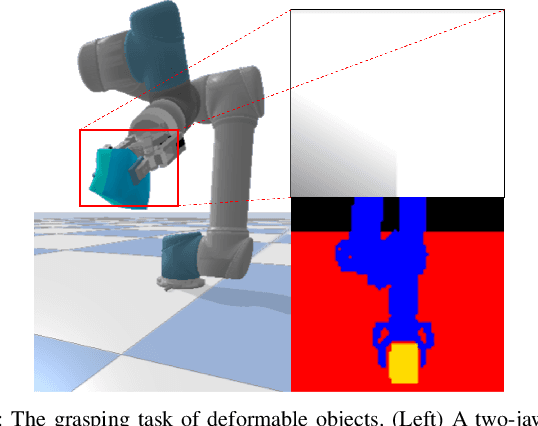

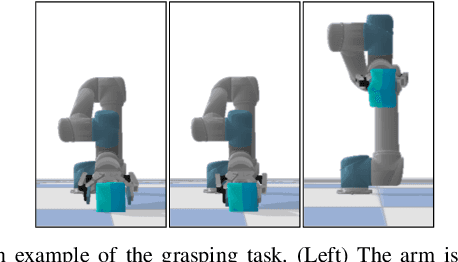

Abstract:We consider the problem of grasping deformable objects with soft shells using a robotic gripper. Such objects have a center-of-mass that changes dynamically and are fragile so prone to burst. Thus, it is difficult for robots to generate appropriate control inputs not to drop or break the object while performing manipulation tasks. Multi-modal sensing data could help understand the grasping state through global information (e.g., shapes, pose) from visual data and local information around the contact (e.g., pressure) from tactile data. Although they have complementary information that can be beneficial to use together, fusing them is difficult owing to their different properties. We propose a method based on deep reinforcement learning (DRL) that generates control inputs of a simple gripper from visuo-tactile sensing information. Our method employs a cross-modal attention module in the encoder network and trains it in a self-supervised manner using the loss function of the RL agent. With the multi-modal fusion, the proposed method can learn the representation for the DRL agent from the visuo-tactile sensory data. The experimental result shows that cross-modal attention is effective to outperform other early and late data fusion methods across different environments including unseen robot motions and objects.
Merry-Go-Round: Safe Control of Decentralized Multi-Robot Systems with Deadlock Prevention
Mar 07, 2025Abstract:We propose a hybrid approach for decentralized multi-robot navigation that ensures both safety and deadlock prevention. Building on a standard control formulation, we add a lightweight deadlock prevention mechanism by forming temporary "roundabouts" (circular reference paths). Each robot relies only on local, peer-to-peer communication and a controller for base collision avoidance; a roundabout is generated or joined on demand to avert deadlocks. Robots in the roundabout travel in one direction until an escape condition is met, allowing them to return to goal-oriented motion. Unlike classical decentralized methods that lack explicit deadlock resolution, our roundabout maneuver ensures system-wide forward progress while preserving safety constraints. Extensive simulations and physical robot experiments show that our method consistently outperforms or matches the success and arrival rates of other decentralized control approaches, particularly in cluttered or high-density scenarios, all with minimal centralized coordination.
Stop-N-Go: Search-based Conflict Resolution for Motion Planning of Multiple Robotic Manipulators
Oct 10, 2024Abstract:We address the motion planning problem for multiple robotic manipulators in packed environments where shared workspace can result in goal positions occupied or blocked by other robots unless those other robots move away to make the goal positions free. While planning in a coupled configuration space (C-space) is straightforward, it struggles to scale with the number of robots and often fails to find solutions. Decoupled planning is faster but frequently leads to conflicts between trajectories. We propose a conflict resolution approach that inserts pauses into individually planned trajectories using an A* search strategy to minimize the makespan--the total time until all robots complete their tasks. This method allows some robots to stop, enabling others to move without collisions, and maintains short distances in the C-space. It also effectively handles cases where goal positions are initially blocked by other robots. Experimental results show that our method successfully solves challenging instances where baseline methods fail to find feasible solutions.
Escaping Local Minima: Hybrid Artificial Potential Field with Wall-Follower for Decentralized Multi-Robot Navigation
Sep 16, 2024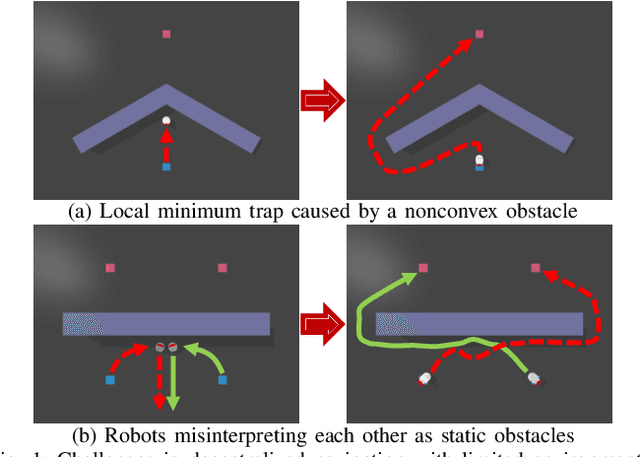
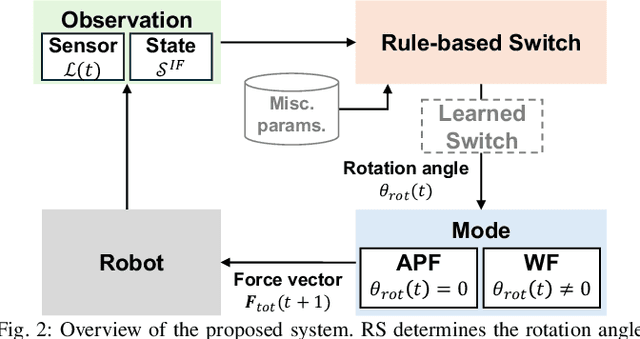
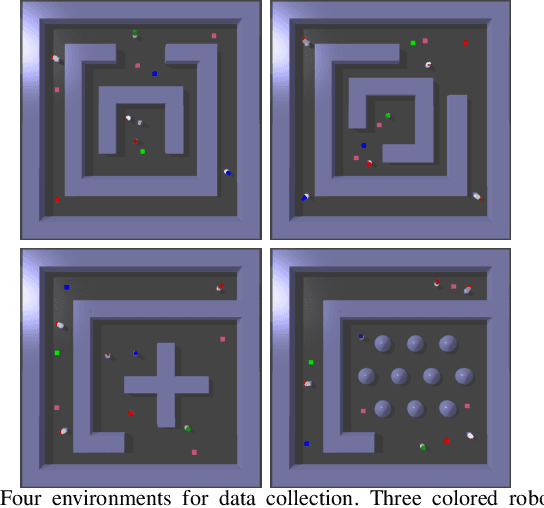
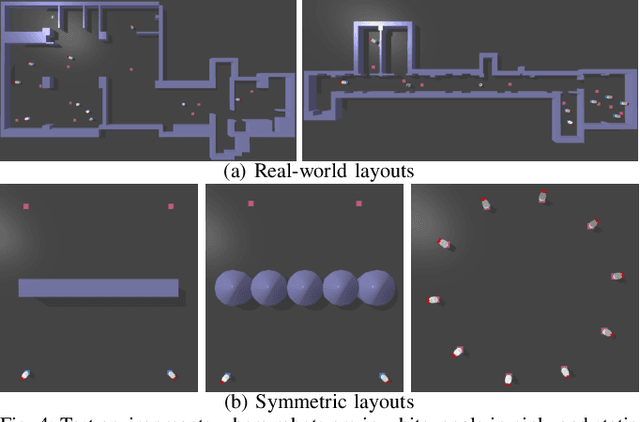
Abstract:We tackle the challenges of decentralized multi-robot navigation in environments with nonconvex obstacles, where complete environmental knowledge is unavailable. While reactive methods like Artificial Potential Field (APF) offer simplicity and efficiency, they suffer from local minima, causing robots to become trapped due to their lack of global environmental awareness. Other existing solutions either rely on inter-robot communication, are limited to single-robot scenarios, or struggle to overcome nonconvex obstacles effectively. Our proposed methods enable collision-free navigation using only local sensor and state information without a map. By incorporating a wall-following (WF) behavior into the APF approach, our method allows robots to escape local minima, even in the presence of nonconvex and dynamic obstacles including other robots. We introduce two algorithms for switching between APF and WF: a rule-based system and an encoder network trained on expert demonstrations. Experimental results show that our approach achieves substantially higher success rates compared to state-of-the-art methods, highlighting its ability to overcome the limitations of local minima in complex environments
Safe Interval RRT* for Scalable Multi-Robot Path Planning in Continuous Space
Apr 02, 2024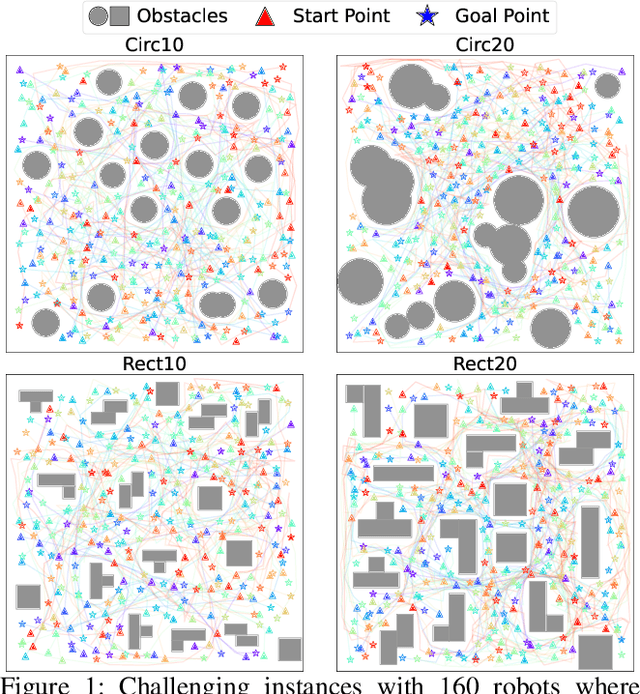
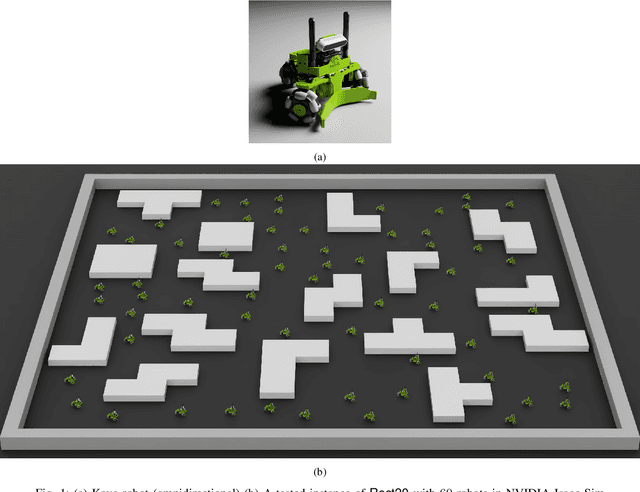
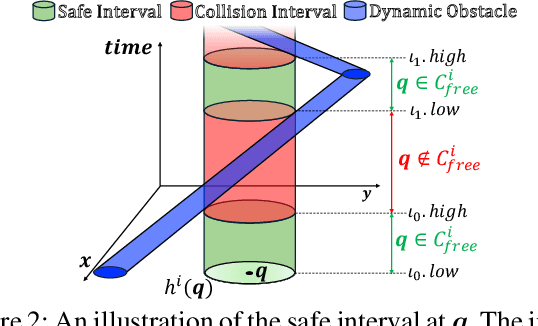
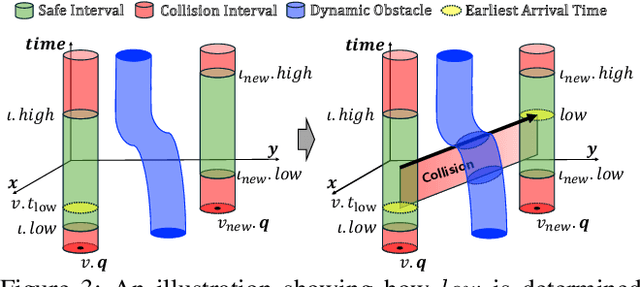
Abstract:In this paper, we consider the problem of Multi-Robot Path Planning (MRPP) in continuous space to find conflict-free paths. The difficulty of the problem arises from two primary factors. First, the involvement of multiple robots leads to combinatorial decision-making, which escalates the search space exponentially. Second, the continuous space presents potentially infinite states and actions. For this problem, we propose a two-level approach where the low level is a sampling-based planner Safe Interval RRT* (SI-RRT*) that finds a collision-free trajectory for individual robots. The high level can use any method that can resolve inter-robot conflicts where we employ two representative methods that are Prioritized Planning (SI-CPP) and Conflict Based Search (SI-CCBS). Experimental results show that SI-RRT* can find a high-quality solution quickly with a small number of samples. SI-CPP exhibits improved scalability while SI-CCBS produces higher-quality solutions compared to the state-of-the-art planners for continuous space. Compared to the most scalable existing algorithm, SI-CPP achieves a success rate that is up to 94% higher with 100 robots while maintaining solution quality (i.e., flowtime, the sum of travel times of all robots) without significant compromise. SI-CPP also decreases the makespan up to 45%. SI-CCBS decreases the flowtime by 9% compared to the competitor, albeit exhibiting a 14% lower success rate.
Ordered sorting of cluttered objects using multiple mobile manipulators
Nov 23, 2022Abstract:We present a search-based planning algorithm to sort objects in clutter using a multi-robot team. We consider the object rearrangement problem in which the objects must be sorted into different groups in a particular order. In clutter, the order constraints could not be easily satisfied since some objects occlude other objects. Those objects occluding others need to be moved more than once to make the occluded objects accessible. This nonmonotone class of the rearrangement prob- lem with order constraints becomes harder if multiple robots are involved, which practically mandates proper computations of robot allocations. The proposed method first finds a sequence of objects to be sorted using a search such that the order constraint in each group is satisfied. The search can solve nonmonotone instances that require temporal relocation of some objects to access the next object to be sorted. Once a complete sorting sequence is found, the objects in the sequence are assigned to multiple mobile manipulators using a greedy allocation method. We develop four versions of the method with different search strategies. In the experiments, we show that our method can find a sorting sequence quickly (e.g., 4.6 sec with 20 objects sorted into five groups) even though the solved instances include hard nonmonotone ones. The extensive tests and the experiments in simulation show the ability of the method to solve the real-world sorting problem using multiple mobile manipulators.
 Add to Chrome
Add to Chrome Add to Firefox
Add to Firefox Add to Edge
Add to Edge